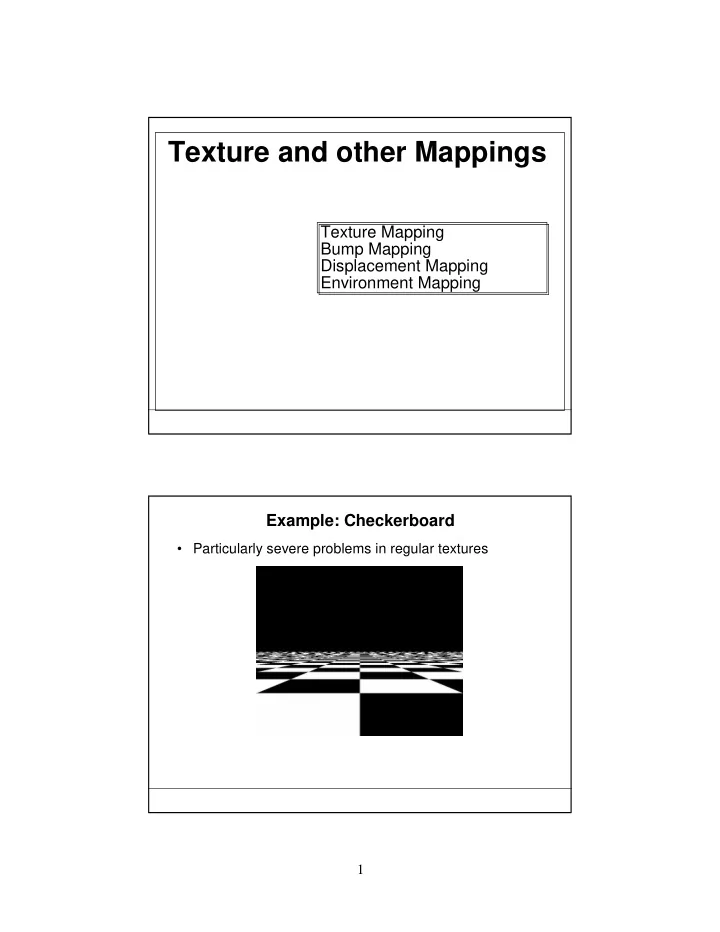

Texture and other Mappings Texture Mapping Bump Mapping Displacement Mapping Environment Mapping Example: Checkerboard • Particularly severe problems in regular textures 1
The Beginnings of a Solution: Mipmapping • Pre-calculate how the texture should look at various distances, then use the appropriate texture at each distance. This is called mipmapping . “Mip” � “multum in parvo” or “many things in a small place” • • Each mipmap (each image below) represents a level of resolution. • Powers of 2 make things much easier. The Beginnings of a Solution • Problem: Clear divisions between different depth levels • Mipmapping alone is unsatisfactory. 2
Another Component: Filtering • Anisotropic filtering – Basic filtering methods assume that a pixel on-screen maps to a square (isotropic) region of the texture – For surfaces tilted away from the viewer, this is not the case! Figure 5. Anisotropic footprints are very common. Image courtesy of nVidia Bilinear Filtering ID Software 3
Trilinear Filtering ID Software Anisotropic Filtering ID Software 4
Side-by-Side Comparison nVidia Or design the mapping by hand 5
Demo: “uvMapper” • www.uvmapper.com Uses for Texture Mapping Use texture to affect a variety of parameters • surface color - color (radiance) of each point on surface (Catmull 1974) - reflectance coefficients k d , k s , or n shiny • surface reflectance • normal vector - bump mapping (Blinn 1978) • geometry - displacement mapping • transparency - transparency mapping (clouds) (Gardener 1985) • light source radiance - environment mapping (Blinn 1978) 6
Radiance vs. Reflectance Mapping + = Sphere w/ Uniform Diffuse coefficient Radiance Map Sphere w/ Radiance Map Texture specifies (isotropic) radiance for each point on surface + = Sphere w/ Uniform Diffuse coefficient Reflectance (k d ) Map Sphere w/ Reflectance Map Texture specifies diffuse color ( k d coefficients) for each point on surface - three coefficients, one each for R, G, and B radiance channels Bump Mapping: A Dirty Trick • Which spots bulge out, and which are indented? • Answer: None! This is a flat image. • The human visual system is hard-coded to expect light from above • In CG, we can perturb the normal vector without having to make any actual change to the shape. 7
Bump Mapping • Basic texture mapping paints on to a smooth surface • How do you make a surface look rough ? – Option 1: model the surface with many small polygons – Option 2: perturb the normal vectors before the shading calculation Real Bump Fake Bump Flat Plane + = Sphere w/Diffuse Texture Map Bump Map Sphere w/Diffuse Texture + Bump Map Bump Mapping • We can perturb the normal vector without having to make any actual change to the shape. • This illusion can be seen through—how? Original model (5M) Simplified (500) Simple model with bump map 8
Bump Mapping Greg Turk Another Bump Mapping Example + = Bump Map Cylinder w/Diffuse Texture Map 9
Displacement Mapping • Use texture map to displace each point on the surface – Texture value gives amount to move in direction normal to surface • How is this different from bump mapping? Environment Mapping Specular reflections that mirror the environment 10
Environment Mapping Specular reflections that mirror the environment Cube is a natural intermediate object for a room eye Environment Mapping: Cube Maps 11
Basics of Texture Mapping in OpenGL Glubyte my_texels[512][512][3]; Gluint texID; glGenTextures(1, &texID); glBindTexture(GL_TEXTURE_2D, texID); glTexImage2D(GL_TEXTURE_2D, 0, GL_RGB, 512, 512, 0, GL_RGB,GL_UNSIGNED_BYTE, my_texels); /* level, components, w, h, border, format, type, tarray */ /* assign texture coordinates */ glEnable(GL_TEXTURE_2D); glBegin(GL_QUAD); glTexCoord2f(0.0, 0.0); glVertex3f(x1,y1,z1); glTexCoord2f(1.0, 0.0); glVertex3f(x2,y2,z2); glTexCoord2f(1.0,1.0); glVertex3f(x3,y3,z3); glTexCoord2f(0.0,1.0); glVertex3f(x4,y4,z4); glEnd(); glDisable(GL_TEXTURE_2D); Grungy details we’ve ignored • Specify s or t out of range? Use GL_TEXTURE_WRAP in glTexParameter because many textures are carefully designed to repeat • Aliasing? Mapping doesn’t send you to the center of a texel. Can average nearest 2x2 texels using GL_LINEAR • Mipmapping: use textures of varying resolutions. 64x64 becomes 32x32,16x16,8x8,4x4,2x2 and 1x1 arrays with gluBuild2Dmipmaps 12
Texture Generation Photographs Drawings Procedural methods (2D or 3D) Associate each x,y,z value directly with an s,t,r value in the texture block (sculpting in marble and granite) Procedural Methods Reaction-Diffusion Greg Turk, Siggraph ‘91 13
Solid Textures • Have a 3-D array of texture values (e.g., a block of marble) – Use a function [xyz] -> [RGB] to map colors to points in space • Such a 3D map is called a solid texture map • In practice the map is often defined procedurally – No need to store an entire 3D array of colors – Just define a function to generate a color for each 3D point • The most interesting solid textures are random ones – a great marble algorithm has now become cliché • Evaluate the texture coordinates in object From: An Image Synthesizer coordinates - otherwise moving the object by Ken Perlin, SIGGRAPH '85 changes its texture! 14
Recommend
More recommend